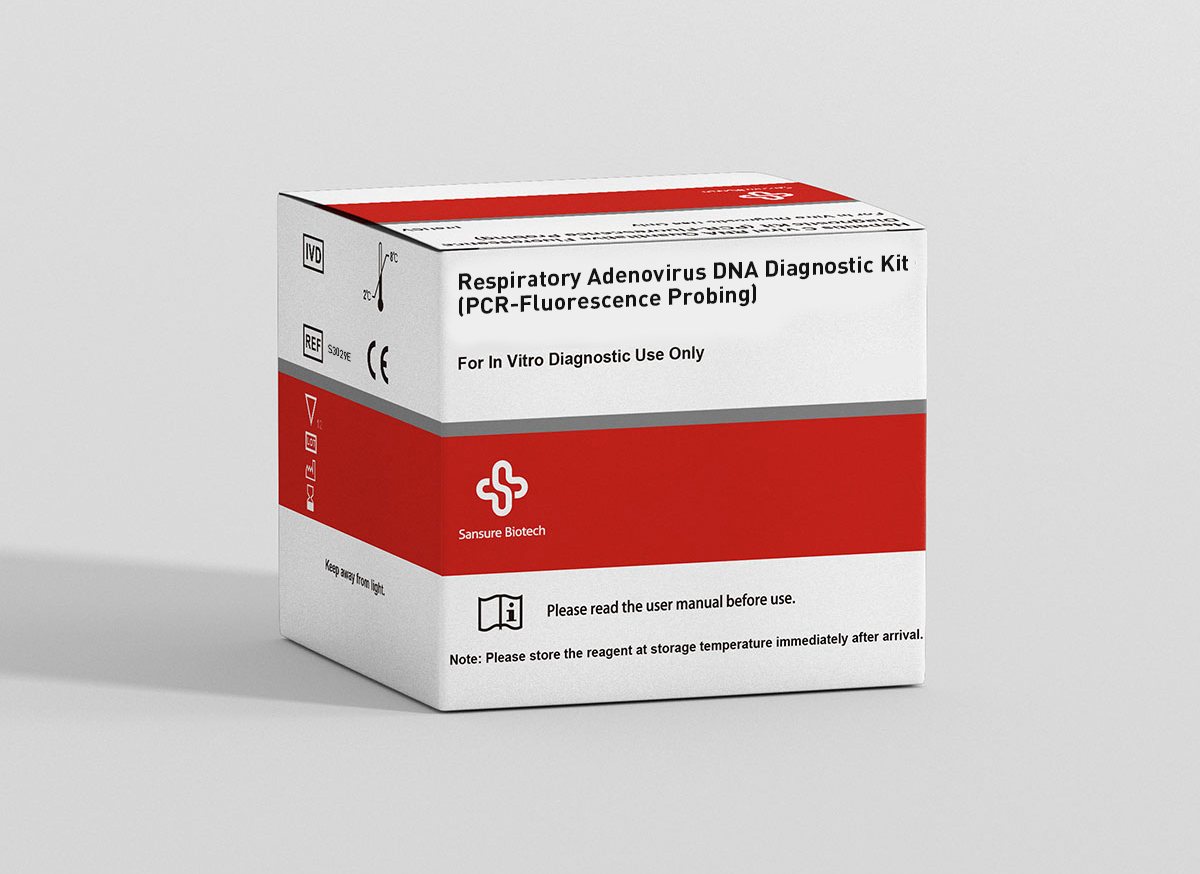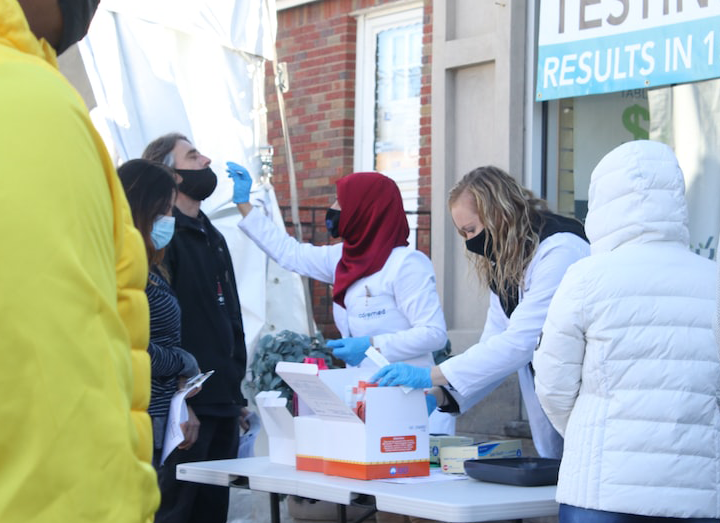Adenovirus, an important pathogen of respiratory tract infection under COVID19 epidemic
Introduction to adenovirus
Adenovirus (ADV) is a non-enveloped icosahedral virus with a double-stranded DNA genome. Since adenovirus was isolated from human tonsillar adenoids by Wallace P. Rowe in 1953 and named after it, more than 120 specific adenovirus serotypes have been identified in humans, mammals, birds, fish and reptiles. Adenovirus is divided into seven subgroups A, B, C, D, E, F and G.
Adenovirus genome structure
Adenovirus has a spherical structure without envelope, and its virions are often arranged in a lattice in the infected nucleus and contain a 26-48 kb linear double-stranded DNA genome, which is transcribed at different times after infection to produce transcripts divided into early (E), intermediate (I) and late (L) regions. The late (L) region encodes structural and nonstructural proteins, which are involved in capsid formation, DNA entrapment, and maturation of progeny adenoviruses. Adenovirus proteins include nucleocapsid proteins, core proteins, and minor proteins. Core proteins include pVII, pV, Mu(pX), pIVa2, terminal protein (TP), and AdV-encoded proteases.

Adenovirus epidemiology
Adenovirus is a common virus that is easy to be infected by human beings, which is mainly transmitted through respiratory droplets and can also be transmitted through feces. The clinical manifestations of adenovirus infection range from asymptomatic to severe, life-threatening respiratory infections and pneumonia. Different sterotypes of adenovirus can cause respiratory infections, respiratory system diseases, keratoconjunctivitis, gastroenteritis, urinary infections and other clinical diseases.

Under COVID19 epidemic, it has been found that adenovirus can be co-infected with SARS-CoV2 and can aggravate the symptoms of patients.

01. Adenovirus and respiratory tract infection
Adenoviruses cause 2%-5% of human upper respiratory tract infections. After normal people are infected with adenovirus, they generally show mild respiratory symptoms, which are self-limiting. However, every year there are outbreaks of adenovirus infection that can lead to severe respiratory infections and pneumonia, and in rare cases, progress to acute respiratory distress syndrome (ARDS), which is treated primarily with supportive care and has a mortality rate of 27- 45%. Outbreaks of ARDS and pneumonia are usually caused by adenoviruses of groups B, C, and E.

02. Adenovirus and epidemic keratitis and conjunctivitis (EKC)
Epidemic keratitis and conjunctivitis are caused by adenovirus infection of the eye, which is highly contagious and can be sporadic or epidemiological. Visual acuity may be affected during the onset of the disease and will return to normal later. For adults, it is mostly limited to external ocular manifestations; for children, there may be systemic symptoms, such as fever, sore throat, otitis media, and diarrhea. For its treatment, local treatment is mainly used, mainly supportive treatment, and no specific drugs.
03. Adenovirus and pharyngeal conjunctival fever (PFC)
Pharyngeal conjunctival fever is a viral conjunctivitis characterized by acute follicular conjunctivitis with upper respiratory tract infection and fever. It is a highly contagious disease infected by adenovirus with no specific medicine and is self-limiting. It is more common in children and adolescents aged 4 to 9 and occurs frequently in schools, kindergartens and summer camps.
04. Adenovirus invasive infection
In immunocompromised populations (eg, HIV-infected patients, patients after solid organ transplantation, and after allogeneic hematopoietic stem cell transplantation), HAdv can be reactivated or produce new infections, and even disseminated HAdv infections can occur, causing multiple organ infections such as enteritis, hemorrhagic cystitis, hepatitis, and pneumonia. The infection rate is as high as 3.0% to 21.0%, and the mortality rate is as high as 7.7% to 38.0%. Mortality is higher especially in pediatric patients with high peripheral blood HAdv load and involvement of multiple organs. Prophylactic ART or early initiation of ART can reduce clinical mortality from HAdv infection. To this end, the European Bone Marrow Transplantation Association (EBMT) published the importance of detection and monitoring of HAdV in blood and stool samples of stem cell transplant recipients, and recommended qPCR diagnostic monitoring of ADV in blood and stool samples for early implementation of treatment measures.

Adenovirus detection
In the laboratory, testing for adenovirus may include culturing adenovirus by cell isolation, using serology to identify adenovirus, and detecting adenovirus by polymerase chain reaction (PCR). However, due to the long culture time of adenovirus cell culture, the limited value of antibody test in immunosuppressed patients, and the lack of quantitative and typing functions, its practical clinical application effect is not good. RT-PCR can directly detect the specific nucleic acid sequence of adenovirus pathogens, which has high specificity and sensitivity, and has the advantage of typing, so it is very popular. The US FDA has already approved a variety of adenovirus nucleic acid detection reagents.

Recently, new breakthroughs have been made in the detection of adenovirus nucleic acid in China. The Respiratory Adenovirus DNA Diagnostic Kit (PCR-Fluorescence Probing) developed by Sansure Biotech has been approved for marketing. The reagent has high sensitivity and can cover a variety of common pathogenic subtypes. It is another powerful tool for the overall solution of respiratory nucleic acid detection.

Drug therapy and vaccine of adenovirus
There is currently no vaccine against adenovirus, and no specific drug approved for adenovirus infection. Due to the lack of prospective studies on adenoviral therapy, the optimal timing of pharmacological intervention is unclear. Most studies of drugs used to treat adenovirus infections have focused on ribavirin and cidofovir, with insufficient data on drug effects. For immunocompromised people, especially children, early diagnosis of adenovirus infection and timely supportive treatment are particularly important. Some large children’s hospitals even recommend adenovirus testing as a screening item for children with respiratory infections.
Note: The picture comes from the Internet. If there is any infringement, please contact the author to delete it.
Disclaimer: All the publications on this website, where the source is indicated, are copyrighted by the original source and do not represent the position of this website.





